Albatross
Diomedeidae
The largest wingspan of any bird in the world!
Advertisement
Albatross Scientific Classification
- Kingdom
- Animalia
- Phylum
- Chordata
- Class
- Aves
- Order
- Procellariiformes
- Family
- Diomedeidae
- Scientific Name
- Diomedeidae
Read our Complete Guide to Classification of Animals.
Albatross Conservation Status
Albatross Facts
- Prey
- Squid, krill, and fish
- Name Of Young
- Chicks
- Group Behavior
- Colonial Nesting
- Fun Fact
- The largest wingspan of any bird in the world!
- Estimated Population Size
- Varies by species
- Biggest Threat
- Depletion of prey from overfishing
- Most Distinctive Feature
- The large size
- Other Name(s)
- Mollymawk or gooney bird
- Gestation Period
- A few months
- Wingspan
- Up to 3.3m (11ft)
- Age Of Fledgling
- 3 to 10 months
- Litter Size
- 1
- Habitat
- Open seas and oceans
- Predators
- Humans, sharks, cats, and rats
- Diet
- Carnivore
- Type
- Bird
- Common Name
- Albatross
- Location
- The Southern Hemisphere and North Pacific
View all of the Albatross images!
The albatross soars gracefully above the oceans, its wings stiff and firm against the strong gusts of wind.
The sight of this familiar seabird and its massive wingspan flying high above the waters has seized the human imagination and inspired myths and folklore around the world for many centuries. It’s a true survivor with all kinds of unique adaptations for dealing with the stressful toll of long periods at sea. But competition with humans for food has caused numbers to rapidly decline.
5 Incredible Albatross Facts!
- According to an old sailing myth, the albatross bird contains the soul of a dead sailor killed at sea. This could represent a good or bad omen, depending on who believes it, but this rather solemn belief did not necessarily stop people from killing or eating them. This was a major plot point in the 1798 poem The Rime of the Ancient Mariner by Samuel Taylor Coleridge. After the main character of the tale kills an albatross, his ship is then visited by a series of misfortunes, and his fellow sailors force him to carry the dead bird around his head as retribution. This is the origin of the term “albatross around the neck.”
- The word albatross comes to us from an Arabic word al-qadus or al-gaṭṭas that means literally “the diver.” The Portuguese then adapted it into the word alcatraz (as in the modern American prison). This was later absorbed into English as albatross.
- Except for the breeding season, the albatross bird is in near constant motion. A typical individual can travel thousands of miles every year.
- An alternate name of the albatross is goony bird for the comical way in which it lands on the ground, tumbling forward.
- Bird watching is a popular past time around the world. The colonies of the northern royal albatross in New Zealand attracts some 40,000 people a year.
You can check out more incredible facts about the albatross.
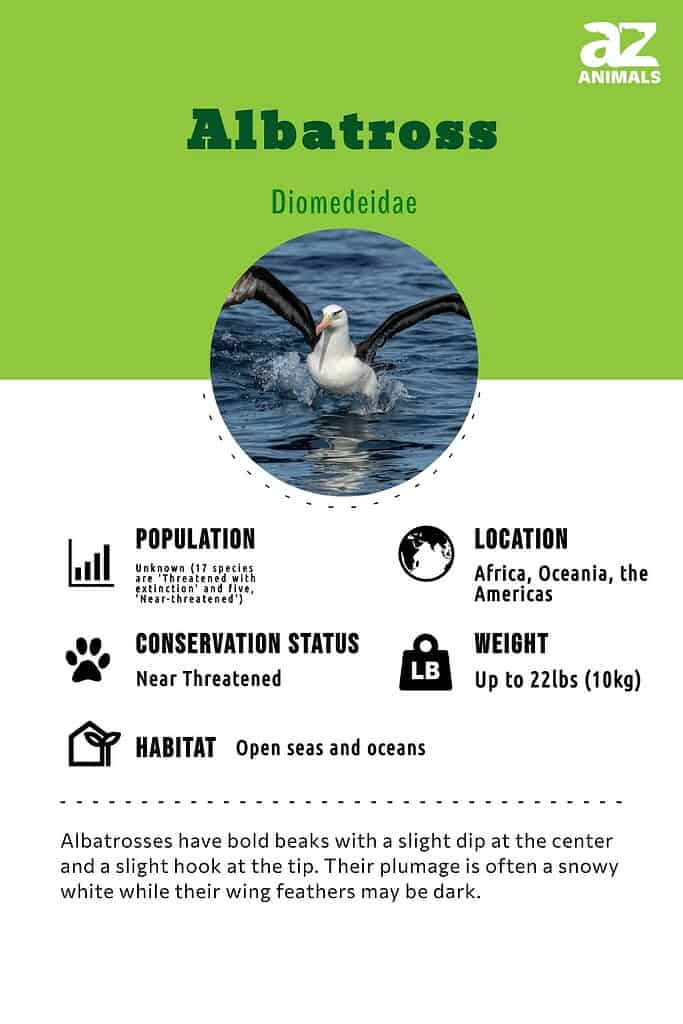
Scientific Name
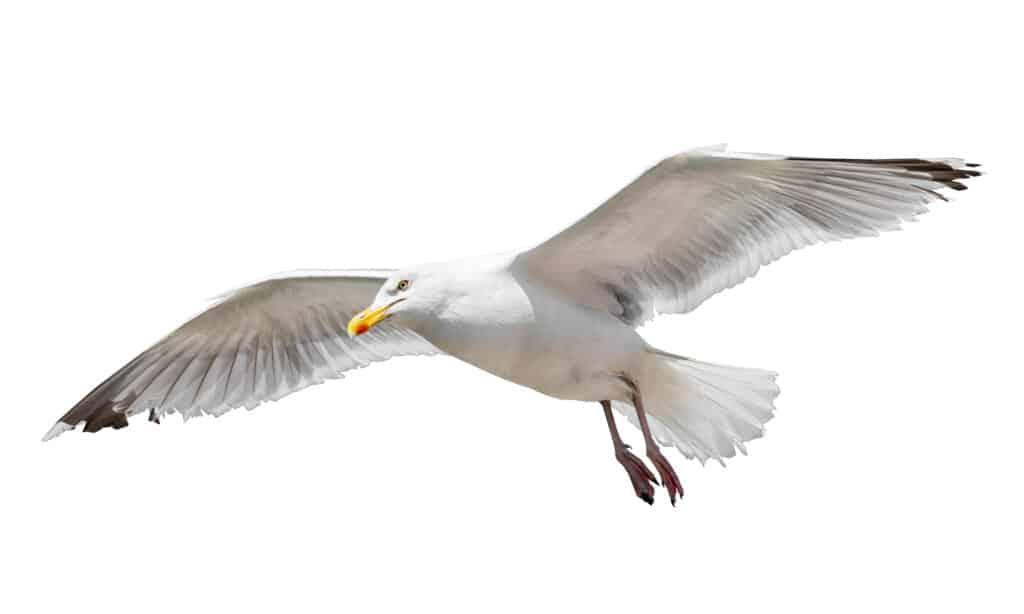
Albatrosses’ scientific name is drawn from Greek mythology
©Marti Bug Catcher/Shutterstock.com
The scientific name of the albatross is Diomedeidae. This derives from the ancient Greek hero Diomedes, who is said to have participated in the Trojan War. According to one legend, albatrosses sang upon his death. Since the classification of the albatross is controversial, there are anywhere between 13 and 24 species, depending on who’s counting. For instance, taxonomists still debate whether the royal albatross is a single species or two northern and southern species. The albatross belongs to the family of Procellariiformes along with petrels, shearwaters, and other seabirds. The last common ancestor of this family was probably alive more than 30 million years ago.
Appearance
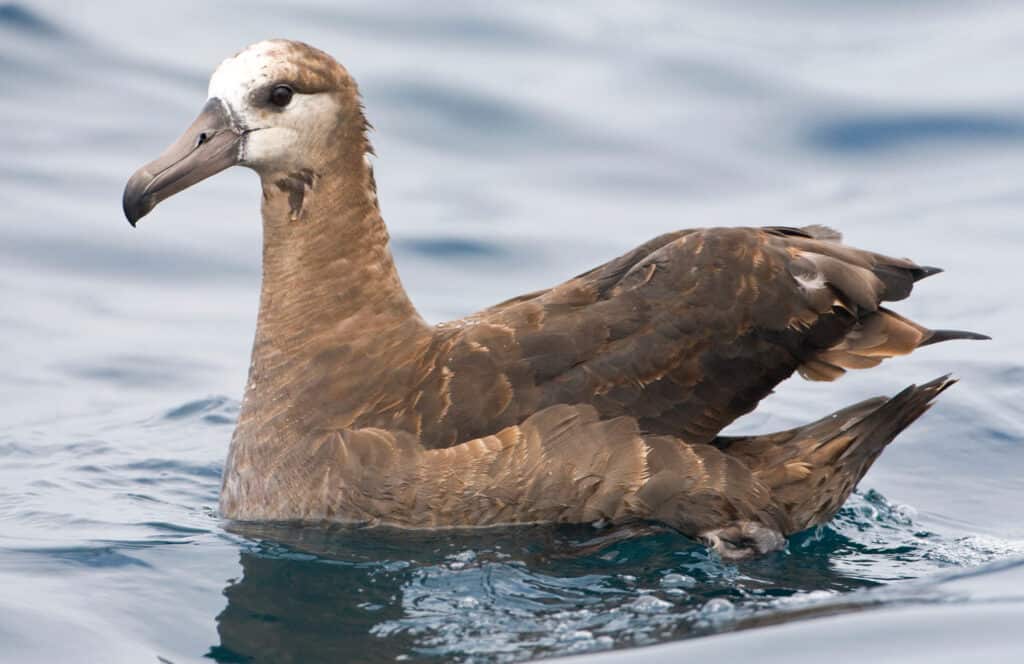
Albatrosses are known for their impressive wingspans
©Agami Photo Agency/Shutterstock.com
The albatross is a strong big-bodied bird with some variation of white, black, or gray coloration (some species have a single color: the southern royal albatross is almost completely white). The long orange or yellow beak is hooked at the end and contains many horned plates. It also has tubes along the side that enable it to measure airspeed in flight.
The most impressive physical characteristic is the sheer size of the wingspan. Judged by the size of the wings, the great albatross (and the wandering albatross species in particular) is the largest living group of birds in the world, stretching 11 feet from tip to tip. It also weighs up to 22 pounds or about the same size as a swan. Even the smaller species have a wingspan of about 6.5 feet, more than most birds.
The wings are stiff and arched, because the albatross rarely flaps them. Instead, the bird glides on the ocean winds for long periods with minimal body movement. This is a necessary adaptation, because they have a lot of weight to carry around. It also means they cannot fly very well in the absence of wind. But the upside is that the albatross expends almost no energy while in flight.
Evolution

The earliest evidence of albatrosses dates back to the Oligocene era
©Jlfutari at English Wikipedia, CC BY-SA 3.0, via Wikimedia Commons – License
The earliest fossil evidence of albatrosses, Tydea septentrionalis dates back to the early Oligocene and was discovered in Belgium. Other fossils dating back to the Eocene and the Oligocene have also been found, in Central Asia, New Zealand, and South Carolina.
Experts believe that the great albatrosses and their North Pacific relatives diverged from each other 15 million years ago, while the mollymawks and sooties diverged about 10 million years ago.
Types

There are 22 species of albatross in the world today
©Don Mammoser/Shutterstock.com
There are 22 species of albatross including:
The great albatrosses (Diomedea)
- Wandering albatross (D. exulans)
- Antipodean albatross (D. (exulans) antipodensis)
- Amsterdam albatross (D. (exulans) amsterdamensis)
- Tristan albatross (D. (exulans) dabbenena)
- Northern royal albatross (D. (epomophora) sanfordi)
- Southern royal albatross (D. epomophora)
Behavior

Albatrosses are capable of drinking seawater thanks to an organ which gets rid of all that excess salt
©iStock.com/hlansdown
The albatross bird is very well-adapted for long periods out at sea. They combine the ability to soar in the air (while expending minimal effort) with the ability to float along the water. Although more vulnerable on the water, the albatross needs to come down occasionally to feed and drink from the ocean. It has a specialized organ that excretes the excess salt it ingests while drinking. Although well-suited for life at sea, the albatross sometimes stops on remote islands for rest. They also return to land in the breeding season and congregate in large colonies which vary in density by species. They seem instinctively to be drawn back to the colony of their birth.
Habitat
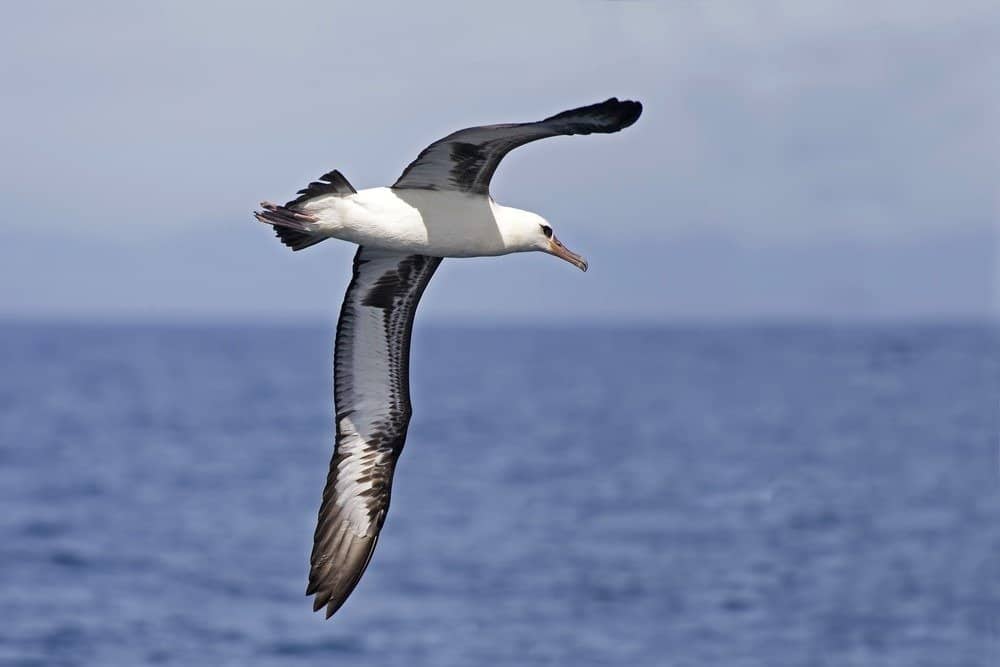
Albatrosses are capable of crossing open oceans if a strong wind is present
©Harold Stiver/Shutterstock.com
The albatross is a native resident of the Southern Hemisphere around Antarctica, South America, South Africa, and Australia. In the distance past, it once had a widespread distribution across much of the Northern Hemisphere, but now only a few species inhabit the Northern Pacific region between Alaska, California, Hawaii, and Japan. With the ability to eat seafood and drink saltwater, the albatross has few problems traversing the open oceans. The only thing it really requires is a strong wind for its survival. It has trouble traversing areas where there are gaps in the wind.
Diet
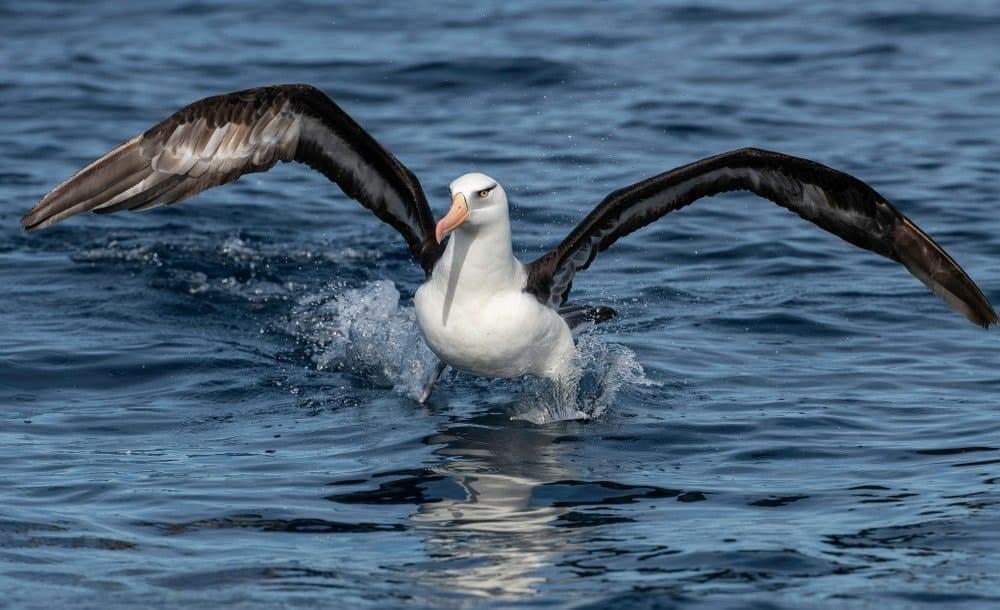
Albatrosses’ diets depend on their species
©wildestanimal/Shutterstock.com
The diet of the albatross consists of squid, krill, schools of fish, and much less commonly, zooplankton (microscopic marine animals). This seabird is also not shy about scavenging. It will trail behind ships to consume their garbage or feast on dead carrion that floats on the surface of the water. The exact nature of its diet varies from species to species. Unlike other predominant sea birds such as penguins, most species (like the wandering albatross) only has the ability to dive a few feet under the water, which makes it difficult to obtain the necessary food to support itself. If it sees the prey from the air, then some species can plunge rapidly into the water to snatch it.
Predators and Threats
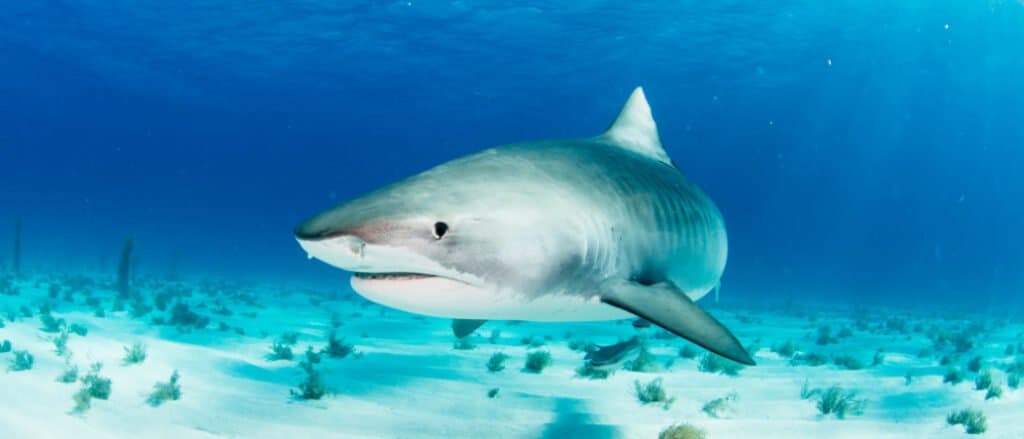
Tiger
sharks are known to occasionally prey on juvenile albatrosses
©Yoshinori/Shutterstock.com
Because it spends so much time floating over the ocean (where no other large carnivores reside), the albatross has few predators, though juveniles are sometimes preyed upon by tiger sharks, and introduced species such as cats and rats will sometimes feast on the albatross eggs.
The only other significant predator is humanity. Some Arctic people might have hunted it as an important source of food in the barren north. Its feathers were also valuable in the creation of luxurious hats. The biggest threat to its survival, though, may be dwindling food supplies as a result of overfishing. The albatross faces constant competition with humans for scarce resources in the open ocean. Another threat is marine pollution that accumulates in the environment and slowly makes its way up the food chain. Slow poisoning can result in abnormal development, reproduction, and eventual death.
Reproduction, Babies, and Lifespan
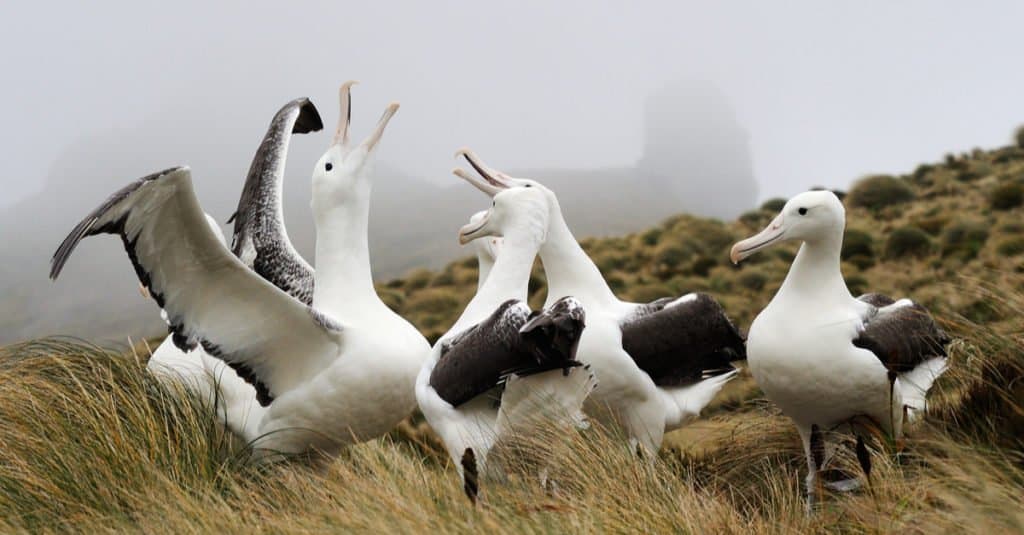
Albatrosses mate for life and both parents care for the young
©AndreAnita/Shutterstock.com
After spending long months out at sea, the albatross will migrate to remote islands and coastal areas to breed. The albatross is quite picky about its choice of mate. Because many species mate for life, they cannot afford to choose the wrong partner. They perform (in human terms) an elaborate song and dance routine to communicate their sexual availability. This is accompanied by preening, staring, bill contact, calling, and pointing. In young birds, this ritual must be perfected and honed through years of trial and error. Eventually, it narrows down its potential mates to a single chosen one. This entire intricate process is integral to their survival.
After pairing up with a mate, the albatross is usually set for life. Even if the couple has difficulty conceiving, they will rarely break up. Since the bond is quite strong, they have a large amount of trust in each other. Together they incubate the egg, rear the young, and construct a large nest out of grass, soil, shrubs, and even feathers. They usually choose a place in a high area with multiple angles of approach.
After copulating, they produce only one egg per breeding season and usually skip a year before breeding again. The young chick hatches from its eggs a few months later undeveloped and highly dependent on its parents for almost everything. In the first stages of its life, the parents alternate between protection duties and food gathering trips. They feed the chick on a mixture of krill, fish, squid, and an oily substance produced in the stomach from other digested prey.
As a result of the scarce flood supply, development is slow and difficult. A few weeks will pass before the chick is old enough to defend itself. It takes another three to 10 months before it fully fledges (meaning that it gains the ability to fly) and begins hunting for itself. The young albatross then spends the next five to 10 years at sea and returns to breed only upon reaching sexual maturity. The life expectancy of the albatross is up to 50 years, but a few longer lived specimens have been observed. Many albatross do not survive the juvenile stage. Learn about the oldest living animals on earth here.
Population

Several albatross species are threatened in some capacity
©Imogen Warren/Shutterstock.com
Decades of human negligence have left the albatross in a bad shape. Of all the species listed by the IUCN Red List, almost every single one is threatened in some capacity. The Laysan albatross, which has a natural range stretching across the entire Pacific, is a near-threatened species with some 1.6 million mature individuals still remaining in the wild. On the other end of the spectrum, the critically endangered waved albatross and the Tristan albatross have only a few thousand members each. Most species exist somewhere between those two extremes with 10,000 to 100,000 mature individuals left. For instance, the gigantic wandering albatross is vulnerable with 20,000 remaining.
Conservationists believe that better management of existing fishery stocks will be necessary to rehabilitate albatross numbers. Habitat restoration and the banning of chemical pollution will also help in this regard. It is not enough for the United States or any single country to act. Because albatrosses roam over such large territories (and because changes in one part of the ocean can disrupt other parts), it will take an international effort to succeed.
Complete Species List
The great albatrosses (Diomedea)
- Wandering albatross (D. exulans)
- Antipodean albatross (D. (exulans) antipodensis)
- Amsterdam albatross (D. (exulans) amsterdamensis)
- Tristan albatross (D. (exulans) dabbenena)
- Northern royal albatross (D. (epomophora) sanfordi)
- Southern royal albatross (D. epomophora)
The North Pacific albatrosses (Phoebastria)
- Waved albatross (P. irrorata)
- Short-tailed albatross (P. albatrus)
- Black-footed albatross (P. nigripes)
- Laysan albatross (P. immutabilis)
The Mollymawks (Thalassarche)
- Black-browed albatross (T. melanophris )
- Campbell albatross (T. (melanophris) impavida)
- Shy albatross (T. cauta)
- White-capped albatross (T. (cauta) steadi)
- Chatham albatross (T. (cauta) eremita)
- Salvin’s albatross (T. (cauta) salvini)
- Grey-headed albatross (T. chrysostoma)
- Atlantic yellow-nosed albatross (T. chlororhynchos)
- Indian yellow-nosed albatross (T. (chlororhynchos) carteri)
- Buller’s albatross (T. bulleri)
The Sooty albatrosses (Phoebetria)
- Sooty albatross (P. fusca)
- Light-mantled albatross (P. palpebrata)
Albatross FAQs (Frequently Asked Questions)
What is an albatross?
The albatross is a family of enormous seabirds that spend most of their time far away from land. It differs from similar seabirds such as petrels and shearwaters by its physical size, skeletal structure, and the location of the tubes on the bill (along the side rather than the top). These tubes assist with the measurement of airspeed.
Do albatrosses sleep while flying?
Some scientists have long assumed that they must sleep in flight due to the long times they spend at sea. The great frigatebird, for instance, really does seem to sleep in short bursts while soaring over the ocean. But a more likely explanation is that the albatross stops at night to sleep on the water. This is based on data from tracking studies that indicate the albatross spend several hours floating on the surface when they would not normally feed.
Where does an albatross lay its eggs?
In the breeding season, the albatross returns to land and creates a nest on high ground close to the shore.
How big is an albatross?
The wingspan of the albatross stretches between 6.5 and 11 feet from tip to tip, depending on the species.
What's the difference between an albatross and a seagull?
Despite their superficial appearance, seagulls and albatrosses belong to entirely separate orders. Seagulls are land-based birds, while albatrosses venture far out to sea. The seagull is also a much smaller bird with a more developed social structure and tool-using abilities. Their densely packed colonies are a cacophony of squawking and noise. The albatross, by contrast, is more concerned with its own family matters than the health of the colony.
Are Albatrosses herbivores, carnivores, or omnivores?
Albatrosses are Carnivores, meaning they eat other animals.
What Kingdom do Albatrosses belong to?
Albatrosses belong to the Kingdom Animalia.
What phylum do Albatrosses belong to?
Albatrosses belong to the phylum Chordata.
What class do Albatrosses belong to?
Albatrosses belong to the class Aves.
What family do Albatrosses belong to?
Albatrosses belong to the family Diomedeidae.
What order to Albatrosses belong to?
Albatrosses belong to order Procellariiformes.
What type of covering do Albatross have?
Albatross are covered in Feathers.
Where do Albatrosses live?
Albatrosses live in the Southern Hemisphere and North Pacific.
In what type of habitat do Albatrosses live?
Albatrosses live in open seas and oceans.
What are some predators of Albatrosses?
Predators of Albatrosses include humans, sharks, cats, and rats.
What is the scientific name for the Albatross?
The scientific name for the Albatross is Diomedeidae.
What is the lifespan of an Albatross?
Albatrosses can live for up to 50 years.
What is a baby Albatross called?
A baby Albatross is called a chick.
What is the biggest threat to the Albatross?
The biggest threat to Albatrosses is the depletion of prey from overfishing.
What is another name for the Albatross?
The Albatross is also called the mollymawk or gooney bird.
How many Albatrosses are left in the world?
The population size of the Albatross varies by species.
How many babies do Albatrosses have?
The average number of babies an Albatross has is 1.
What is an interesting fact about Albatross?
The Albatross has the largest wingspan of any bird in the world!
How fast is an Albatross?
An Albatross can travel at speeds of up to 50 miles per hour.
Thank you for reading! Have some feedback for us? Contact the AZ Animals editorial team.
Sources
- National Geographic, Available here: https://www.nationalgeographic.com/animals/birds/group/albatrosses/
- Britannica, Available here: https://www.britannica.com/animal/albatross
- Smithsonian Magazine, Available here: https://www.smithsonianmag.com/science-nature/the-amazing-albatrosses-162515529/
- Niels C. Rattenborg. Sleeping on the wing. , Available here: https://www.ncbi.nlm.nih.gov/pmc/articles/PMC5206601/

















